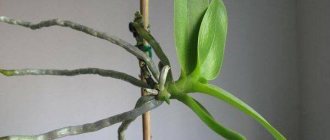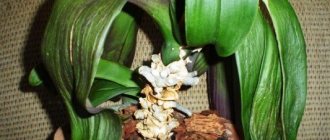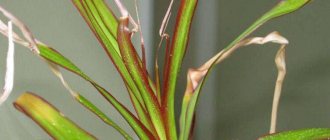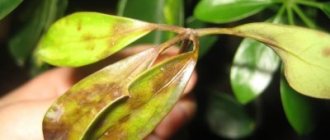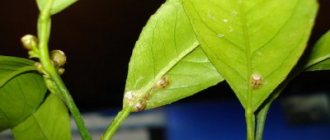Orchids strewn with buds are not uncommon for a flower shop. But achieving repeated flowering (even if not so abundant) at home can be difficult. What kind of care do epiphytes need so that they regularly form buds?
The trend of giving potted orchids instead of a traditional bouquet is gradually waning. But even without this, almost every home has at least one tropical plant (for example, phalaenopsis, vanda, dendrobium, cymbidium, etc.). Someone managed to make friends with capricious epiphytes and achieve almost continuous flowering. Some people are happy with 3-4 flowers on a single arrow. And some even have to observe only stringy leaves and aerial roots from year to year.
What is a flower shoot?
Peduncle - a shoot (arrow) running upward from the base of the plant on which flowers are formed, or, in a narrower sense, a segment of the plant stem on which flowers are formed.
The peduncle is very similar to the root of an orchid, so often inexperienced gardeners make irreparable mistakes in caring for the plant, which can lead to the fading or death of the peduncle. What are the main differences between a peduncle and a root?
- The shape of the root is round, and the peduncle is cone-shaped.
- The flowering shoot appears only from the leaf axil.
- The arrow appears above the previous flowering site.
- The presence of irregularities on the peduncle - buds - is mandatory.
Most often, the orchid produces flower stalks in the fall, when the temperature differences between day and night are large: from +25C to +15C. The average period for the formation of a flower arrow is 2 – 3 months (from the moment of appearance to the stage of the formed peduncle). If the grower creates comfortable conditions for the plant, this process can be accelerated. At the same time, this will guarantee that the home beauty will definitely bloom.
Time and place of appearance
A stem appears on which the flowers will grow, in the axils of the leaf blades. The axil is the angle between the stem and the leaf. This is where the flower bud is formed.
The most favorable season for the growth of new shoots is autumn. New leaves usually appear in summer.
The period from the beginning of the growth of the peduncle to the opening of the buds takes about two months. The duration of growth is affected by light: the more light, the faster the growth process will progress.
Note that the side stem forms much faster: beautiful flowers will bloom within a month and a half, and in some cases even after a month.
How important is flowering?
The peduncle is the most important part of the orchid. Some florists call it the “heart” of the plant. It is this that provides all the beauty of the orchid, since flowers form on it. As you know from biology lessons, a flower is a means by which a plant attracts insects for pollination, that is, for procreation. As confirmation of this, it is on the peduncles that babies appear, which can then be easily rooted and a new plant can be obtained (read about how to grow a baby on an orchid peduncle here).
While the orchid's peduncle is growing, the plant should under no circumstances be replanted (we talked in detail about caring for the orchid before and during flowering here)!
Why doesn't the plant shoot out shoots?
Important. The reasons why problems with the peduncle arise depend on what type of orchid we are talking about. Without knowing the specifics of caring for a particular orchid variety, you cannot hope for its systematic, abundant flowering!
All orchids are divided into sympoidal and monopoidal. The latter have only one growth point, the bush does not divide, it has no dormant period: vandas, phalaenopsis, ascocendes. Sympoidal ones need a period of rest, which should be properly ensured. In other words, what is good for phalaenopsis and dendrobium will be irrelevant for vanda, cymbidium, and cattleya.
Before expecting the peduncle to grow from an orchid, you need to familiarize yourself with specialized literature on the issue of creating the necessary conditions for maintaining a certain type of flower. And then it is necessary to analyze: why does the orchid not produce a peduncle, are the conditions created suitable for it, and if they are unsuitable, then what should be done? If the epiphyte does not have enough light, the watering schedule is not adjusted, the correct temperature regime is not maintained, or the plant has been fed for a long time, then flowering is out of the question.
Some florists resort to special preparations, for example, cytokinin paste. It is a phytoharmone, its main purpose is to awaken dormant buds, form shoots in the intended place, and accelerate the flowering of the plant. Another drug is succinic acid (4 tablets per 1 liter of water). Place a pot of orchid in a solution of acid and water overnight. In order for an orchid to send out a flower stalk, doing this once is not enough - a similar procedure should be carried out at least once a week.
General information about the peduncle
Peduncles can grow in the most interesting ways: sometimes they bend like a pig's tail, and then rise sharply. In addition, the shoot can grow in any direction - in this case it is necessary to organize a support for the escape.
It is sometimes difficult for novice gardeners to distinguish the peduncle from the root. Let's figure out what the differences are between them.
Firstly, the shoot has a pointed tip, while the root has a rounded and blunt tip. Secondly, already at the very beginning of growth, the peduncle has a complex structure. The rudiments of future scales are visible on the shoot. The spine is absolutely smooth.
What if there is no escape or it is frozen?
In order to find out why the arrow is not growing, you first need to make sure that the plant is healthy. Perhaps the reason lies in some kind of disease. And, of course, it is worth analyzing whether all conditions for caring for the orchid that has released a peduncle are provided. If not, then you must do everything possible to ensure that they are met.
In order for the released arrow to bloom, certain requirements must be met:
- Lighting. Orchid loves a lot of diffused light. The daylight hours for the arrow to emerge must be at least 12 hours, otherwise this can lead to the peduncle fading. The best place is south-east or south-west windows.
- Temperature. Orchid is a tropical plant that loves warmth. It feels comfortable at +25C, but the night temperature should be an order of magnitude lower: the difference between day and night temperatures should be about 5C.
- Watering. The general rule for watering all orchids remains in force: as the soil dries.
- Humidity. We should not forget about systematically spraying the plant with warm, settled water, while not forgetting about watering. However, direct impact on the plant can also be destructive, so experienced gardeners advise “enveloping” the orchid with water dust: placing the epiphyte in the center of a group of other plants and spraying them.
- Feeding. Important elements for the flower during the shoot season are phosphorus and potassium. It is better to fertilize the plant with special fertilizers for orchids, purchased in a store (for example, Agricola), 1 - 2 times a month until the period of active flowering.
Further care for the orchid
If the plant was able to be revived, further care must be properly organized, otherwise the weakened flower will get sick again.
To do this, it is necessary to prevent waterlogging of the soil and regularly feed Phalaenopsis. Good lighting is of great importance. To prevent new diseases, it is necessary to visually inspect orchid leaves as often as possible. Such an examination will help to promptly identify any symptoms of trouble: yellowing, fading or cracking. Do not forget about timely transplantation. If the foliage at the base of the stem begins to fall off, wrinkle or burst, immediate action must be taken, otherwise the orchid may dry out. The main thing is not to repeat the mistakes that led to plant disease
Experts say that most problems in caring for Phalaenopsis are caused by an improper microclimate in the room. Therefore, if it is not possible to create suitable conditions for an orchid, it is better to choose a less capricious and high-maintenance plant. Phalaenopsis and other varieties of tropical “guests” need careful and delicate treatment.
What to do if there are no buds?
Many orchid lovers complain that their beauties “sit” in place, not pleasing with their blooms for several years. What needs to be done in such a situation for the plant to shoot? To begin with, just try to move the flower to a new place. If it doesn’t help, then there are several options for “shock therapy”, which are strongly recommended by experienced florists.
Temperature changes
- Move the flower with the pot to a place where there is a temperature difference of 5C - 7C: it should be cool at night, warm during the day. The best place is a balcony, veranda.
- It is imperative to check for drafts, as the plant does not tolerate them and may die.
Shading and reducing humidity
- Move the container with the epiphyte to a darker place than the one to which it is accustomed.
- Reduce as much as possible and sometimes completely stop watering the plant, giving it a kind of “drought.”
- After 1.5 -2.5 weeks, carry out the first moderate watering.
Reducing the frequency of watering
Reduce watering the orchid by half: for example, if watering was carried out once every 5 days, then you need to start watering the plant once every 10 days.- Between dry intervals, moderate watering with boiled water at room temperature is recommended.
- You cannot spray the plant at this time or moisten the substrate with a spray bottle.
It is unacceptable to use several techniques at the same time, as this can lead to the death of the flower!
What stimulants can be used
Sometimes it happens that just agrotechnical measures are not enough for flowering. In this case, it is necessary to use stimulants.
Succinic acid is an effective stimulant. For 1 liter of water you need 4 tablets of the drug.
To stimulate flowering, the pot is placed in a prepared succinic acid solution overnight. This procedure is carried out regularly every 7 days.
You can also use cytokinin paste to force the flower to produce a peduncle.
But experienced flower growers advise not to get carried away with stimulants. Succinic acid will be quite enough.
The fact is that stimulants weaken the orchid. She spends all her energy on flowering. This undermines her immunity, and she becomes easily vulnerable to diseases and pests.
You can use both store-bought drugs and products prepared according to folk recipes.
ON A NOTE. Store-bought stimulants are much more effective, since they contain a higher concentration of the main active ingredient.
Getting multiple stems at home
The number of flower stalks on an orchid directly depends on the genetic characteristics of the species that was acquired. An important role is played by such factors as the age of the plant, the power of its root system, the quantity and quality of lighting, regularity of watering, and compliance with the optimal temperature regime.
Provided that all requirements for the care and maintenance of the orchid are met, you can try to increase the number of flower stalks as follows:
- After flowering, cut off old flower stalks (making sure they are completely dry).
- Treat leaves and substrate with fungicide.
- Feed the plant with specialized fertilizers for orchids.
After the orchid peduncle dries to the very base, it should be trimmed. To do this you will need sharp scissors or pruning shears and activated carbon. Using a sharp, clean tool, cut off the dried peduncle, not reaching two centimeters to the surface of the substrate. The cut area is treated with crushed activated carbon.
Some florists advise: not cut off the peduncle completely, but to the very top “dormant” bud, since a lateral arrow may begin to develop from it, and a second shoot may appear from the axil of the leaves. In this way it will be possible to obtain a plant with two peduncles.
Basic Rules
You must know the basic rules of pruning in order to minimize injury to the plant.
First you need to pay attention to the selection of devices that you cannot do without. These include:
- Garden pruning shears are the best option, as they do not injure the stem when pruning. You can replace it with sharp scissors or a knife, but you need to act carefully.
- Alcohol or other disinfectant (you can use bleach or the boiling method). They need to treat the tool before cutting.
Next you need to determine the cut point:
- If it is a peduncle (peduncle), then you need to trim it above the dormant bud at a height of one or two centimeters. Moreover, the closer the bud is to the leaf rosette, the more flowers will be formed on the later lateral shoot. However, re-blooming should be expected no earlier than two to three months after pruning.
- If it is an aerial root (rotten or completely rotten, frozen, dry, dying), then pruning is done to include one or two centimeters of healthy tissue. Remember that in this case you will also need to transplant the plant into a suitable pot with fresh substrate.
- If it is a leaf (dry, diseased, frozen, yellowed, swollen, etc.), then pruning is done so as to capture about two centimeters of healthy tissue.
Next, you need to process the cut area. Crushed activated carbon, ground cinnamon, brilliant green or iodine are suitable for this. Any of these products is an excellent antiseptic that disinfects. Then the treated cut area must be dried for at least twenty minutes.
How to direct the arrows to grow upward?
Wait until the arrow reaches a length of 15 - 20 cm. While it is green, it is very flexible and can easily change the direction of its growth.- The grown shoot must be fixed in a vertical position using a support in the pot and a special clothespin (elastic band, hairpin, etc.).
- If there is a risk of injury to the peduncle or even breaking it, then fixation can be carried out gradually. In order to bring the peduncle as close as possible to the support, it is tied with an elastic band, rope, tape or bandage to the holder, gradually reducing the distance between them over time.
We suggest watching a video on how to properly secure a peduncle so that it begins to grow upward:
Preventing problems
It should be noted that in their natural environment - the tropics - orchids grow on trees from which their flower stalks hang under the weight of buds and flowers. Therefore, the growth of shoots not vertically upward, but horizontally is a natural process for this plant, inherent in nature. The only way to prevent such a situation at home is to constantly turn the orchid pot as the peduncle deviates to the side. It will reach towards the light, thereby aligning itself.
As for the problems of “freezing” of the growth of the peduncle or the reluctance of the orchid to bloom at all, there is only one recommendation: strictly adhere to the requirements for the maintenance and care of a certain type of orchid.
Caring for an orchid is a labor-intensive process. Difficulties can arise at every step. Only perseverance, determination, and attentiveness of the gardener will help him achieve the main goal when growing an orchid - admiring the beauty of the flower for a long time.
Caring for a trimmed orchid
Before pruning, in addition to tools, you need to stock up on products that will cauterize the cut site and prevent pathogenic bacteria from penetrating inside. Activated carbon, iodine, brilliant green, potassium permanganate or cinnamon are used as such agents. After the orchid is trimmed, the cut is lubricated with a disinfectant solution or drying powder is rubbed in. In some types of orchids, the peduncle is hollow inside. In this case, the cut must be sealed with beeswax to prevent water from getting inside or pests from entering. Getting rid of uninvited residents who have settled inside the stem is much more difficult than driving them out of the leaves.
Caring for an orchid involves more than just replanting and cutting the flower stem. When replanting, the dried and rotten parts of the rhizomes are cut off from the plant, leaving only the roots that have a green or gray appearance. But this may not be enough. It happens that an orchid does not bloom for several years, as it is overloaded with green mass. In this case, cut off excess leaves
And here it is especially important to know how to trim the leaves of an orchid. Improper pruning can destroy the plant.
Cut flower stalk of phalaenopsis
How to trim orchid leaves correctly:
- Always cut off the lower leaves.
- When starting pruning, the leaf is cut along the midline and torn to the stem.
- Gently tear off the halves from the stem with your hands.
- Do not water the orchid for several days, allowing the wounds to dry out so that the orchid does not rot.
Do the same with dried and yellowed leaves. If the leaf is green but flaccid, you should wait, perhaps it will gain elasticity. And if it does start to turn yellow, you need to wait until it completely dries and cut it off. Under the removed leaves, anything can be found: from young aerial roots to a new shoot that has begun to form.
